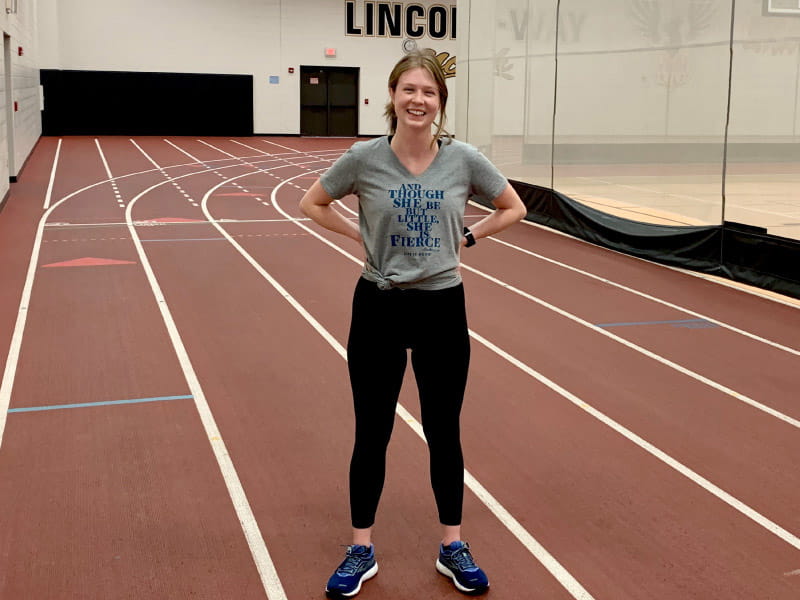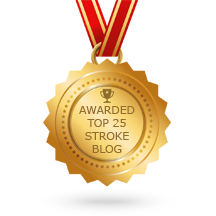Ask your doctor why you didn't get 100% recovered like she did! Don't be polite about it, screaming may be required, and the competence of your doctor should be in question! In my stroke survivor opinion, all stroke doctors should have EXACT 100% RECOVERY PROTOCOLS! They've known since medical school that stroke rehab was a compete fucking failure and should have initiated research that solved that problem. At least leaders would do that. Isn't your doctor a leader?
The only other stroke survivors that I know got back to running are these:
Tommye-K. Mayer book; 'Teaching Me to Run'.
Ta’Mara Aarin couldn’t sit up after a stroke, but readies for LA 2024 marathon July 2023
The latest here:
2 strokes in a month at 27 left her partially paralyzed. Now 31, she runs and hikes.
By Deborah Lynn Blumberg, American Heart Association News
Molly Fitzgerald woke up one fall morning with intense pain in her neck. It was so bad she thought about going to the emergency room. But Molly eventually pegged the pain to work stress. Maybe the migraines she'd had lately were also to blame, she thought.
She took pain medicine and used a heating pad, trying to ride things out. A week later, the pain was still there, so she went to an urgent care facility near her Minneapolis home. After doing an electrocardiogram, or EKG, to look at her heart's electrical activity, the doctor said nothing was wrong.
"But I don't feel right," Molly said.
Worried she was being dramatic, Molly went home with a muscle relaxant.
She woke up one day soon after feeling dizzy. She stood up from bed and almost fainted. In the bathroom, her body kept leaning to the right. She kept vomiting.
The word "stroke" popped into her head. She dismissed it. She was only 27. Strokes were for older people, she thought, and her face and speech were fine.
It was probably a reaction from the muscle relaxant, she thought. She collapsed on the couch to rest and called her mother, Karen Fitzgerald.
"Go to the hospital," Karen said.
In the ER, Molly waited for hours. She got an anti-nausea medication. It could be the flu, a doctor said, or maybe vertigo, a spinning sensation that can be linked to issues with the inner ear. Ultimately, he proposed a treatment that could help stop the spinning.
Molly had another idea. "Let's do some scans first," she said.
She had an MRI and CT scan to look at her brain activity. Soon after, the doctor came into her room.
"So," he said, "you had a little stroke."
She'd had a cerebellar stroke, one that happens when blood is restricted to the part of the brain that controls body and eye movement and balance. The cause was vertebral artery dissection, when the wall of an artery in the back of the neck tears and blood supply to the brain is blocked. It wasn't clear why it happened. The doctor prescribed medicine to prevent blood clots from forming.
"Hopefully this will never happen again," the doctor said.
Molly walked out of the hospital a few days later.
Over the next few weeks, she had dizzy spells and headaches. Once, she felt a cold sweat on one side of her body. She went to the ER.
"You're probably just healing," another ER doctor said.
A month after her stroke, Molly was a few days from returning to her marketing job at a local dairy company. She had brunch with a friend, caught up with her parents in Chicago and went to take a nap.
Suddenly, on the way to bed she felt an intense pain in her head. Her jaw locked up. She looked at herself in the mirror. Her mouth wasn't drooping. But Molly was nervous. What if it was another stroke? She called a friend who lived five minutes away to come over.
Molly put on her shoes and fed her cat, Gigi. Bending over, she got a huge headrush, then her ears started ringing. Her vision was distorted; everything looked tinted green.
"Oh no, it's another stroke," she told herself. Molly grabbed her phone to call 911. But she kept opening the calculator app.
Finally, she dialed.
"I think I'm having a stroke," she told the operator.
"How do you know?" the operator said.
"Because I've already had one," said Molly.
EMTs and Molly's friend arrived at the same time. Molly couldn't talk. Her left side was paralyzed. Paramedics asked if it was possible Molly had taken any drugs.
"She doesn't even drink coffee right now," her friend said.
In the ambulance, Molly threw up while on her back, causing her to feel like she was suffocating.
"Stay with us," the EMT said as Molly's eyes fluttered closed. "Stay awake."
When her parents, Donald and Karen, arrived at the hospital, Molly was in bed, shaking. The left side of her face drooped. For days, she couldn't walk.
An avid runner, she feared she'd never run again. When she started therapy, she felt dizzy and sick her first time using a walker. It didn't last long. She was disappointed.
"Why are you being so hard on yourself?" Donald asked.
"I thought I'd be a great student," Molly said.

Soon, though, she started seeing progress. Ten days later, she was walking again. Then she went to stay with her parents in Chicago at her childhood home.
It was Thanksgiving and she relished being with her sisters, one older, one younger. To support Molly's recovery, Donald set up an agility course in the basement with a reclining bike, a soccer ball and an air hockey table.
"We always talk about grit," he said. "Molly's got grit and she just keeps pushing."
Molly also did occupational therapy and physical therapy to get her strength back. Months later, in the fall of 2020, when COVID-19 canceled all marathons, Donald created his own 26.2-mile run in the Chicago suburbs as a fundraiser for stroke research in Molly's honor.
Donald and his brother-in-law, Jim Haack, wore red T-shirts that said, "Miles with a Purpose." They raised nearly $7,000 for the American Heart Association. Molly ran the last mile with her dad and uncle.

The following summer, Molly had recovered enough to fulfill a longtime dream. She moved to San Francisco.
Now, five years after her strokes, Molly is 31. When she's not working doing brand marketing for a California coffee manufacturer, she enjoys running and hiking in various parts of California. The only off-limits activities are things that could tear her artery again, such as water skiing and riding a roller coaster.
She still has frequent periods of fatigue, especially after intense physical activity or busy workdays, and gets migraines every few months. "Fatigue from brain damage isn't something you can muscle through," she said.
Also an avid knitter, Molly got a tattoo of a knitting swatch with several knitting errors in it. The image sends two messages: her challenges and her triumphs.
"You do have certain deficits that you carry as scars," she said. "But you learn to manage them, and today I'm pretty good compared to where I was. I feel very lucky."

Stories From the Heart chronicles the inspiring journeys of heart disease and stroke survivors, caregivers and advocates.
American Heart Association News Stories
American Heart Association News covers heart disease, stroke and related health issues. Not all views expressed in American Heart Association News stories reflect the official position of the American Heart Association. Statements, conclusions, accuracy and reliability of studies published in American Heart Association scientific journals or presented at American Heart Association scientific meetings are solely those of the study authors and do not necessarily reflect the American Heart Association’s official guidance, policies or positions.
Copyright is owned or held by the American Heart Association, Inc., and all rights are reserved. Permission is granted, at no cost and without need for further request, for individuals, media outlets, and non-commercial education and awareness efforts to link to, quote, excerpt from or reprint these stories in any medium as long as no text is altered and proper attribution is made to American Heart Association News.
Other uses, including educational products or services sold for profit, must comply with the American Heart Association’s Copyright Permission Guidelines. See full terms of use. These stories may not be used to promote or endorse a commercial product or service.
HEALTH CARE DISCLAIMER: This site and its services do not constitute the practice of medical advice, diagnosis or treatment. Always talk to your health care provider for diagnosis and treatment, including your specific medical needs. If you have or suspect that you have a medical problem or condition, please contact a qualified health care professional immediately. If you are in the United States and experiencing a medical emergency, call 911 or call for emergency medical help immediately.




No comments:
Post a Comment